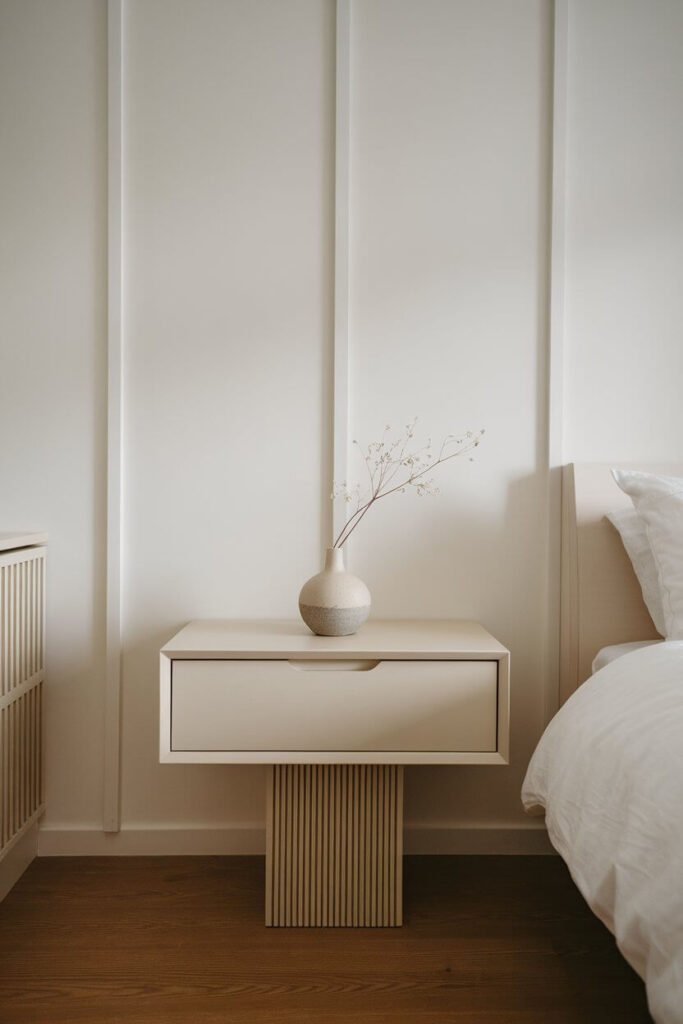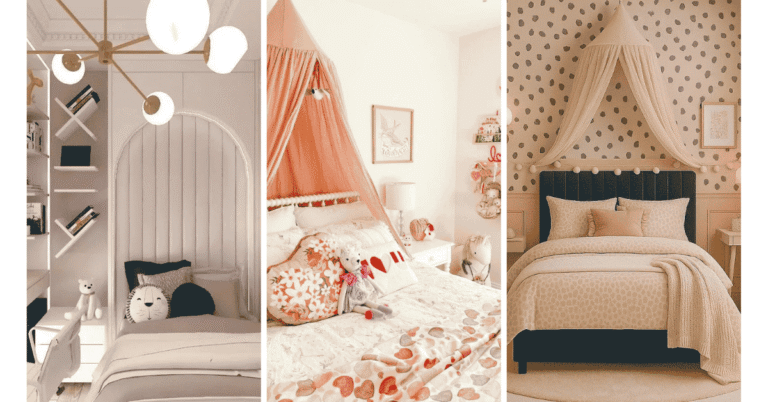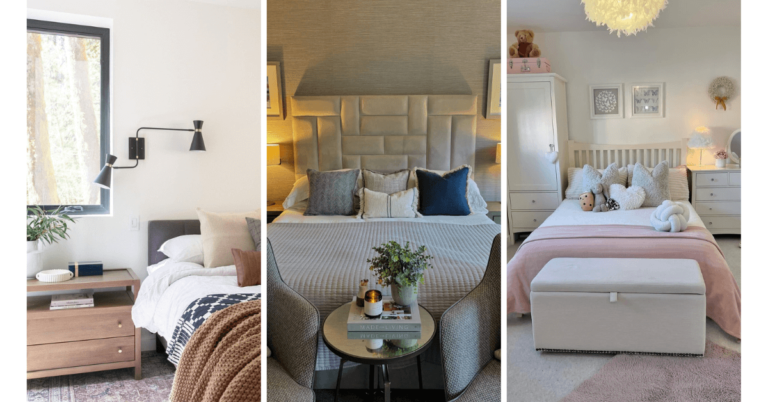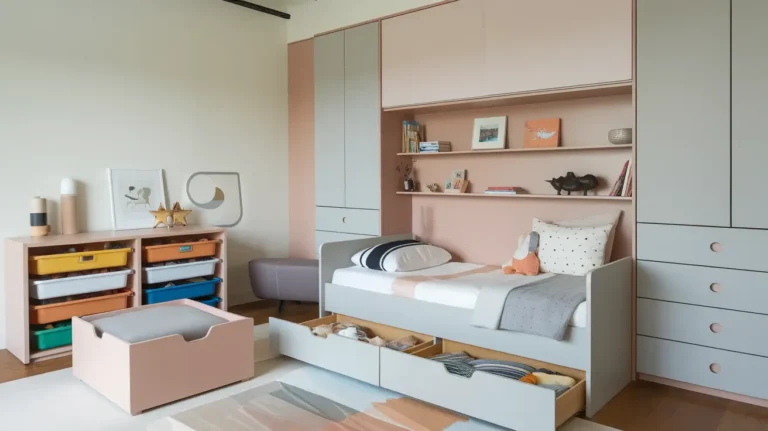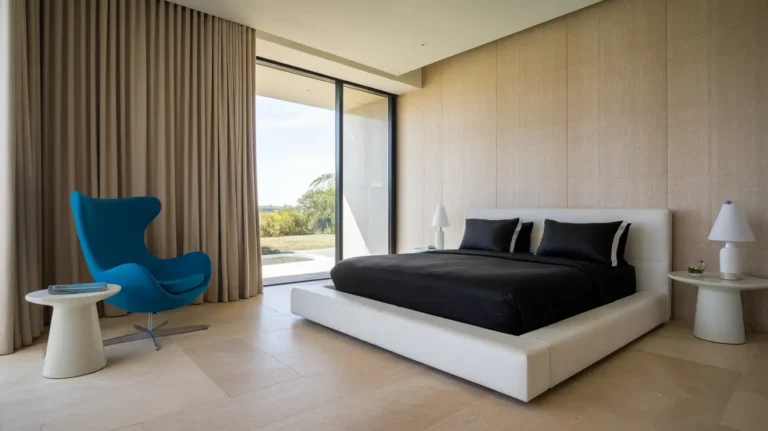15 Japandi Bedroom Design: Minimalist & Cozy Decor Ideas

Japandi is making waves in the world of interior design, and for good reason. A fusion of Japanese minimalism and Scandinavian coziness, this aesthetic emphasizes simplicity, functionality, and a deep connection to nature.
Japandi effortlessly blends clean lines, warm textures, and a muted color palette, creating spaces that are serene yet stylish.
If you’ve been dreaming of turning your bedroom into a tranquil oasis, this article is your roadmap.
We’ll explore the core elements of Japandi design and offer 15 must-try ideas to help you achieve the perfect Japandi aesthetic.
The Key Elements of Japandi Bedroom Design
Before we jump into the ideas, it’s important to understand the foundation of Japandi design. Here are three essential pillars to consider when reimagining your space:
- Low-Profile Furniture: Think platform beds, simple headboards, and functional yet minimal nightstands. Keeping furniture close to the floor creates a grounded, calming atmosphere.
- Natural Materials: Linen, cotton, wood, bamboo, and wool add warmth and texture. These elements don’t just look good; they are eco-conscious and sustainable, too.
- Wabi-Sabi Philosophy: Japandi embraces the Japanese concept of Wabi-Sabi, which finds beauty in imperfection. Handcrafted ceramics or asymmetrical decor items can infuse your space with authenticity.
15 Japandi bedroom design
1. Low Bed Frames
Invest in a platform bed that sits close to the floor, as it not only enhances the minimalist look but also creates a feeling of openness and calm in your bedroom.
The low height helps to create a grounded, tranquil atmosphere and makes the room feel more spacious, even in smaller spaces. Pair it with crisp white organic linens for a clean aesthetic, and layer it with a woven throw or a textured blanket in neutral tones for that cozy-meets-minimalist vibe that defines Japandi style.
A plush, low-profile mattress works perfectly with this setup, ensuring both comfort and style. Add a small bedside table with a simple design to complement the look, and consider placing a small potted plant or a soft, warm light for added coziness.
2. Neutral Color Palette
Stick to a soft, neutral color palette of whites, beiges, and greys to establish a serene and calming backdrop, which is essential for Japandi interiors. These colors create a sense of order and simplicity, perfect for unwinding after a busy day.
Introduce muted earthy tones like sage green, terracotta, or soft brown through decorative pillows, rugs, or planters to add subtle contrast and warmth. These colors evoke a sense of balance and harmony, key to blending the Japanese and Scandinavian design ethos.
To add depth to your palette, layer light tones with slightly darker accents, such as charcoal or deep brown, while keeping the overall look cohesive.
3. Wood Slat Accent Walls
Enhance the texture and warmth of your room by incorporating vertical or horizontal wood slat panels. These can be used as a feature wall behind your bed or on one side of the room to create a striking focal point without overwhelming the minimalist aesthetic.
Light, natural wood tones like ash or birch give a Scandinavian feel, while richer, darker woods like mahogany or walnut add a traditional Japanese touch. This technique not only adds depth and character but also enhances the sense of warmth and coziness in the room.
For added detail, you can even use slats to conceal built-in lighting or create a seamless headboard effect, adding function to your design.
4. Layer Textures
Japandi design thrives on the interplay of different textures, which create visual interest without resorting to clutter. Layer cotton sheets, linen duvet covers, and wool or jute rugs to achieve a tactile, inviting look.
These natural materials bring an organic, grounded quality to the space while remaining understated. Introduce cushions or ottomans with woven, knotted, or tufted details for additional texture.
Consider adding a light throw blanket with tassels or fringe to soften the overall aesthetic. Keep the design minimal by sticking to a few high-quality pieces, as Japandi values functionality and simplicity over excess.
5. Natural Light
Maximize natural light by opting for sheer linen or cotton curtains that softly diffuse sunlight while maintaining privacy. These lightweight fabrics allow the room to feel airy and bright without blocking out the natural beauty outside.
Use light-colored window treatments, such as creams or off-whites, to maintain the room’s open and serene vibe. In darker rooms, strategically place mirrors to reflect and amplify natural light, creating a brighter and more open space.
Skylights or large windows, if available, can act as a central feature, connecting the room to the outdoors and enhancing the Japandi principle of harmony with nature.
6. Angular Wooden Furniture
Select wooden furniture with clean, geometric lines to complement the Japandi aesthetic. Low-profile dressers, angular chairs, or sleek wooden nightstands provide both functionality and visual appeal.
Choose light woods like oak, pine, or bamboo for a Scandinavian touch, or opt for darker options like walnut or teak for a Japanese-inspired look. These pieces bring warmth and practicality to your space while making a bold yet understated design statement.
To enhance the minimalist vibe, look for furniture with hidden storage solutions, such as beds with built-in drawers or benches that double as storage chests. Simple yet intentional design choices in your furniture will help the space feel uncluttered and balanced.
7. Nature-Inspired Art
Choose artwork that reflects the beauty of nature, such as botanical prints, minimalist landscapes, or abstract pieces in earthy tones like moss green, warm taupe, or clay.
Simple framed prints or canvas art can add character to the room without overwhelming the space or disrupting the clean lines of Japandi design.
For a more authentic touch, consider incorporating traditional Japanese art, such as hanging scrolls with calligraphy or nature scenes, or understated Scandinavian posters featuring natural motifs. You can also use pottery or ceramic sculptures as decorative pieces to tie in the natural theme.
8. Tall Greenery
Bring the outdoors in with tall plants like fiddle leaf figs, rubber plants, or bamboo stalks. These eye-catching plants not only purify the air but also introduce a sense of height and verticality to your space, creating a stunning contrast to low-profile furniture common in Japandi design.
Their lush, green foliage adds vibrancy and life, making your room feel more serene, organic, and inviting.
Choose decorative pots in neutral tones or natural materials like ceramic or terracotta to seamlessly blend with the overall aesthetic.
9. Under-Bed Rugs
Anchor your bed with a soft, neutral rug in shades like beige, cream, or soft grey to enhance the warmth and coziness of your bedroom. An under-bed rug adds texture and creates a sense of harmony and visual cohesion with the rest of the decor.
Make sure the rug is large enough to extend beyond the sides and foot of the bed, framing the furniture perfectly.
A rug with a subtle pattern or woven detail can further elevate the minimalist Japandi design while maintaining the balance between simplicity and comfort.
10. Globe Lighting
Incorporate globe-shaped lighting fixtures such as pendant lights, table lamps, or floor lamps to bathe your space in soft, diffused light. These gentle glows create a calming ambiance that aligns perfectly with Japandi’s minimalist and tranquil aesthetic.
Opt for materials like frosted glass, matte metal, or natural wood finishes to ensure the lighting elements remain clean and elegant.
Place these fixtures strategically to layer the lighting in your room, making it both functional and atmospheric.
11. Rustic Accents
Add handcrafted decor pieces like wooden trays, ceramic vases, or woven wall hangings to introduce a sense of artisanal craftsmanship and authenticity to your space.
These rustic elements provide a tactile, textured contrast to Japandi’s smooth, sleek surfaces, adding warmth and character.
Items with natural imperfections, such as hand-thrown pottery or raw-edge wood, celebrate the Japanese philosophy of wabi-sabi, emphasizing the beauty of imperfection and simplicity.
12. Clutter-Free Nightstands
Choose nightstands with built-in storage, such as drawers, shelves, or hidden compartments, to neatly organize books, electronics, or other small items that can create clutter.
Keeping surfaces clean and uncluttered reinforces the calm and peaceful atmosphere central to Japandi design.
Consider adding a single decorative item like a small ceramic vase, a minimalist candle, or a natural stone sculpture to bring an understated yet personal touch to the space.
13. Black Accents
While Japandi design emphasizes light, airy spaces with neutral tones, small black accents can provide a sense of depth, balance, and sophistication. Incorporate subtle black elements such as a bedside lamp, picture frames, or a sleek, minimalist vase.
These accents create contrast, grounding the overall design and giving the space a more dynamic, intentional feel.
For an added layer of texture, opt for matte finishes or natural black materials like basalt or iron.
14. Functional Decor
In Japandi, form and function go hand in hand. Decorative items should also serve a purpose. For example, a folding shoji screen can act as a room divider, offering privacy while doubling as a stunning piece of art.
Similarly, beautifully crafted storage baskets, sculptural lighting fixtures, or a minimalist tea set can function both as practical tools and as stylish decor.
This dual-purpose approach not only saves space but also embodies the Japandi principle of thoughtful simplicity.
15. Woven Accessories
Enhance the organic feel of your Japandi-inspired space with woven accessories like rattan baskets, bamboo lamps, or jute rugs. These natural, textured pieces tie together the earthy tones of the design while adding warmth and depth.
Use woven storage items to keep your essentials neatly organized, contributing to the clean and clutter-free environment. Alternatively, let them function as standalone decor pieces to emphasize the connection to nature.
Combining functionality with aesthetic appeal, woven details are a perfect fit for the Japandi lifestyle.
FAQs
How much does a Japandi bedroom makeover cost?
The cost can vary depending on your selections, but you can start small with affordable accessories like linen bedding or handmade decor. A full makeover with furniture might range from $1,000 to $5,000 based on quality and scale.
Can Japandi work in small bedrooms?
Absolutely. Using low-profile furniture, light colors, and vertical storage solutions can make a small room feel open and airy.
Where can you find Japandi-style furniture?
Look for sustainable and natural options at stores like IKEA, West Elm, or local craft-based shops. Online platforms like Etsy often offer handmade pieces that align with the Japandi philosophy.
Can bright colors be used in Japandi design?
Bright colors aren’t typical of Japandi design, but muted versions like dusty blue or pale pink can add warmth without disrupting the serene aesthetic.
Bottom Lines
The Japandi design philosophy goes beyond aesthetics; it’s about creating a space that nurtures tranquility, mental clarity, and well-being.
By integrating natural materials, thoughtful furniture, and a neutral color palette, your bedroom transforms into a restorative retreat.
Start small by adding a soft linen throw or incorporating natural wood accents. If you’re ready for a full transformation, these 15 ideas will guide you toward a cohesive Japandi look. Take your first step into a serene lifestyle.












